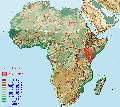magnidentata [S.](M)
Sergentomyia (Sergentomyia) magnidentata Davidson, 1987b
CARACTERES DIAGNOSTIQUES
Cette espèce n’a été trouvée qu’au Kenya. Elle ne peut être confondue avec aucune autre espèce par la taille de ses dents mandibulaires. Elle ressemble superficiellement à S. yusafi en se basant sur la forme de la plage pigmentée et la longueur du segment antennaire. La longueur du labre est aussi discriminante.
DESCRIPTION
Sergentomyia magnidentata Davidson, 1987b. Journal of the Entomological Society of Southern Africa, 50 (2) : 343-349. [Mâle, Femelle].
TYPE
Holotype femelle, Afrique du Sud : Transvaal, Tzaneen, Letsitelle, habitations, 1.III.1932 (Dépôt ?).Holotype femelle, Kenya : Kitui, Kauriro, latrines, 23.IX.1965 (British Museum Natural History). Paratypes : 9 femelles et 10 mâles, diverses localités au Kenya, (South African Institute for Medical Research, Johannesburg et British Museum Natural History, Londres),
BIOLOGIE
Biotopes : savane ouverte avec termitières.
Fluctuations : inconnues.
Développement larvaire : inconnu.
Préférences trophiques : inconnues.
Importance médicale : rôle vecteur inconnu.
Sergentomyia (Sergentomyia) magnidentata mâle
A. cibarium; B. pharynx; C. fourreau pénien (Paratype # 3001, Kenya, SAIMR Coll.)
ABDOMEN
- ABDOMEN : Forme de l'insertion des soies des tergites II à VI : elliptique et circulaire
- ABDOMEN : Pigmentation des segments IV, V et VI : pigmentation uniforme
- ABDOMEN : Taille du tergite VI : pas plus développé que le V
AILE
- AILE : Largeur de l'aile (mm) M : > 0,20 & <= 0,30 ; > 0,30 & <= 0,50
- AILE : Longueur de l'aile (mm) M : >1,25 & <= 1,50
- AILE : Rapport longueur / largeur de l'aile M : > 4,5 & <= 5 ; > 4 & <= 4,5
GENITALIA
- GENITALIA : Disposition des épines des styles à 4 ou 5 épines : 2 2 proches
- GENITALIA : Distibution des soies sur le coxite : absent
- GENITALIA : Extrémité du lobe latéral : inerme
- GENITALIA : Extrémité du paramère ou de son lobe le plus long : arrondie
- GENITALIA : Forme du fourreau pénien : épais et digitiforme
- GENITALIA : Forme générale du paramère : unilobé
- GENITALIA : Lobe basal du coxite : absent
- GENITALIA : Longueur de la pompe génitale (µm) : <= 100
- GENITALIA : Longueur du coxite (µm) : <= 150
- GENITALIA : Longueur du filament génital (µm) M : < 250
- GENITALIA : Longueur du fourreau pénien (µm) M : <= 75
- GENITALIA : Longueur du lobe latéral (µm) : > 150 & <= 250
- GENITALIA : Longueur du style (µm) : <= 100
- GENITALIA : Nombre d'épines du style : 4
- GENITALIA : Rapport longueur du coxite / longueur du style : > 2 ; > 1.5 & <= 2 ; > 1 & <= 1.5 ; <= 1
- GENITALIA : Rapport longueur du filament génital / pompe génitale : > 3 & <= 4 ; > 2 & <= 3
- GENITALIA : Rapport longueur du lobe latéral / longueur du coxite : <= 1
- Sexe : Mâle
- GENITALIA : Soie non caduque du style : sur le 1/3 distal
PATTE I
RÉPARTITION
- RÉPARTITION : Espèces connues d'un pays donné : Kenya
- RÉPARTITION : Espèces connues d'un pays et des pays limitrophes : Zanzibar (Tanzanie) ; Tanzanie ; Soudan ; Somalie ; Pemba (Tanzanie) ; Ouganda ; Kenya ; Éthiopie
SPERMATHÈQUE
TÊTE
- TÊTE : Alignement des dents du cibarium M : sur une ligne concave vers l'arrière
- TÊTE : Armature cibariale M : sans dents ou avec dents rudimentaires
- TÊTE : Aspect des dents médianes M : comme les latérales
- TÊTE : Comparaison des segments antennaires AIII avec AIV + AV : AIII < AIV + AV
- TÊTE : Denticules du cibarium M : 2 rangées ou plus
- TÊTE : Disposition des dents du cibarium M : nettement séparées
- TÊTE : Formule antennaire M : 1/III-XV
- TÊTE : Longueur du segment antennaire AIII (µm) M : <= 120
- TÊTE : Nombre de dents du cibarium M : 21 à 30 ; 11 à 20
- TÊTE : Plage armée du pharynx M : petite
- TÊTE : Plage pigmentée du cibarium M : absente
- TÊTE : Rapport segment antennaire AIII / Epipharynx M : > 0.5 & <= 1
- TÊTE : Rapport segment antennaire AIV / ascoïde IV (c/b) M : >1 & <=2
- TÊTE : Formule palpale M : 1-2-3-4-5



